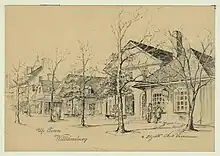Elizabeth O'Neill Verner
Elizabeth O'Neill Verner (December 21, 1883 – April 17, 1979) was an artist, author, lecturer, and preservationist who was one of the leaders of the Charleston Renaissance.[1] She has been called "the best-known woman artist of South Carolina of the twentieth century."[2]
Early life and education
Elizabeth Quale O'Neill was born Dec. 21, 1883, in Charleston, South Carolina. She first studied art with Alice Ravenel Huger Smith.[2] In 1901, after attending a Catholic girls’ school in Columbia, S.C.,[3] she enrolled at the Pennsylvania Academy of Fine Arts, where she studied for two years with Thomas Anshutz.[2]
When she left the academy, she taught art in Aiken, South Carolina, for a time.[2] She then returned to Charleston, where she took up her art studies with Smith as well as with Gabrielle D. Clements and Ellen Day Hale.[4] Inspired by Clements and Hale, she was a founding member of the Charleston Etchers Club[5] and helped to found the Southern States Art League.[2]
In 1907, she married E. Pettigrew Verner, with whom she had two children.[2]
Art career

Verner did not become a professional artist until after her husband's death in 1925 left her the sole means of support for her children.[5] With advice from Smith, she worked to adapt her craft so that she could be self-supporting.[6] One avenue she took, like some of her contemporaries, was to publish her prints in books with titles like Prints and Impressions of Charleston that could be sold to tourists.[5] Another avenue was to seek commissions, and she came to specialize in making drawings of historic buildings in the cause of preservation.[2] Among her clients were Williamsburg Historic District, Harvard Medical School, the United States Military Academy, Princeton University, and the University of South Carolina.[2]
Verner made etchings, drypoints, drawings, and (after 1934) pastels of Charleston, favoring buildings, street scenes, and landscapes. She worked at a studio within her residence at 38 Tradd Street. She also became a portraitist known for representing African-Americans, especially the city's flower vendors.[2] She worked occasionally as a book illustrator, illustrating DuBose Heyward's novel Porgy.[2] Stylistically, her paintings are realism with impressionist overtones, while her etchings and drawings are crisply detailed studies.
Verner traveled extensively, visiting Japan (1937), Europe, the Caribbean, and Mexico.[2] In London, she examined some of Rembrandt's etchings in the British Museum. While in Kyoto, Japan in 1937, she learned Japanese brushwork, and produced about 12 etchings.[3] She inspired her friend Anne Taylor Nash to take up painting,[7] serving as her teacher for a time.[8] In 1946, Verner published “Other Places,” which made up 42 illustrations of places other than Charleston, accompanied by her own commentary.[9]
She died on April 17, 1979. Her work is held by the Harvard Art Museums,[10] the Delaware Art Museum,[11] the Charleston Museum,[12] the University of Michigan Museum of Art,[13] the Smithsonian American Art Museum,[14] and others. The South Carolina Arts Commission awards the Elizabeth O’Neill Verner Governor’s Awards for the Arts in her honor.
References
- Severens, Martha (1999). William Halsey. Greenville County Museum of Art. p. 13. ISBN 096032464X.
- "Verner, Elizabeth". The Johnson Collection website.
- "<sc>charles reagan wilson</sc> and <sc>william ferris</sc>, editors. <italic>Encyclopedia of Southern Culture</italic>. Assisted by <sc>ann j. abadie</sc> and <sc>mary l. hart</sc>. Chapel Hill: University of North Carolina Press, for the Center for the Study of Southern Culture, University of Mississippi. 1989. Pp. xxi, 1634. $59.95". The American Historical Review. April 1991. doi:10.1086/ahr/96.2.592. ISSN 1937-5239.
- Jules Heller; Nancy G. Heller (December 19, 2013). North American Women Artists of the Twentieth Century: A Biographical Dictionary. Taylor & Francis. pp. 1561–1563. ISBN 978-1-135-63889-4.
- "The Charleston Renaissance". Florence County Museum website. Retrieved Jan. 22, 2016.
- "THE CHARLESTON RENAISSANCE". fineartstrader.com. Archived from the original on 11 August 2015. Retrieved 26 April 2015.
- "The Paintings of Anne Taylor Nash » Telfair Museums". 18 July 2014. Retrieved 31 January 2017.
- A Southern Collection. University of Georgia Press. 1 February 1993. pp. 150–. ISBN 978-0-8203-1535-5.
- Baruth, Christopher (1995-06-01). "American Places Dictionary: A Guide to 45,000 Populated Places, Natural Features, and other Places in the United States". Cartographic Perspectives (21): 42–43. doi:10.14714/cp21.879. ISSN 1048-9053.
- Harvard. "From the Harvard Art Museums' collections Christ Church, Cambridge, Massachusetts". harvardartmuseums.org. Retrieved 2021-02-12.
- "Cyrus". emuseum.delart.org. Retrieved 2021-02-12.
- "Bay Street, Beaufort | Charleston Museum". www.charlestonmuseum.org. Retrieved 2021-02-12.
- "Exchange: Side Entrance, Charleston". exchange.umma.umich.edu. Retrieved 2021-02-12.
- "Elizabeth O'Neill Verner | Smithsonian American Art Museum". americanart.si.edu. Retrieved 2021-02-12.